I defined in python some shapes with corresponding corner points, like this:
square = [[251, 184],
[22, 192],
[41, 350],
[244, 346]]
triangle = [[250, 181],
[133, 43],
[21, 188]]
pentagon = [[131, 37],
[11, 192],
[37, 354],
[247, 350],
[256, 182]]
Then, I make use of NetworkX package to create a Graph:
G = nx.DiGraph()
Then, I create a node in the graph for each shape:
G.add_node('square', points = square, center = (139, 265))
G.add_node('triangle', points = triangle, center = (139, 135))
G.add_node('pentagon', points = pentagon, center = (138, 223))
Now is the problem, I have to create some edges connecting two nodes if a condition is satisfied. The condition to satisfy is if the center of a shape is inside or outside another shape, then create an edge like this:
G.add_edge('triangle', 'pentagon', relation = 'inside')
G.add_edge('triangle', 'square', relation = 'outside')
To do so, I have to loop through the nodes, extract the center of a shape, extract the points of the other shapes (NOT themselves, it's useless) and make the pointPolygonTest.
I've been trying quite much, but didn't came out with any solution. The closest (not really effective) solution I got is this:
nodes_p=dict([((u),d['points']) for u,d in G.nodes(data=True)])
nodes_c=dict([((u),d['center']) for u,d in G.nodes(data=True)])
for z,c in nodes_c.items():
print z + ' with center', c
for z,p in nodes_p.items():
p_array = np.asarray(p)
if cv2.pointPolygonTest(p_array,c,False)>=0:
print 'inside ' + z
#create edge
else:
print 'outside ' + z
#create edge
This, gives me the following output, that is not optimal because there are some relation that should have been avoided (like triangle inside triangle) or some wrong relations (like pentagon inside square)
triangle with center (139, 135)
inside triangle
outside square
inside pentagon
square with center (139, 265)
outside triangle
inside square
inside pentagon
pentagon with center (138, 223)
outside triangle
inside square
inside pentagon
How can I solve this problem? Any suggestion is apreciated. Reminder: the main problem is how to loop through the nodes and extract the info. The packages I import for the whole script are:
import numpy as np
import networkx as nx
import cv2
